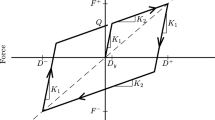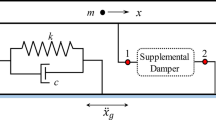Abstract
This study presents a new design method that concurrently determines the stiffness and damping coefficient in a base isolation system. This design method is developed based on the similarity between the active and passive control system. Then, the stiffness and damping coefficient are derived from the linear quadratic regulator control algorithm to a single degree of freedom superstructure and formed as a function of single weighting. The best design of a base isolation system is determined by optimizing this weighting from the minimum H∞-norm responses of base displacement and roof acceleration. A parametric study is performed to understand the influence of superstructures to the resulting optimized base isolation system. Moreover, this study also provides a numerical example to validate the optimal design of base isolation systems. The potential to design nonlinear lead-rubber bearings with added viscous dampers based on the proposed method is also investigated. As a result, the proposed method yields a high-performance base isolation system for a known superstructure.










Similar content being viewed by others
References
Buckle I, Nagarajaiah S, Ferrell K (2002) Stability of elastomeric isolation bearings: experimental study. J Struct Eng 128(1):3–11
Chang CM, Spencer BF, Shi P (2014) Multiaxial active isolation for seismic protection of buildings. Struct Control Health Monit 21(4):484–502
Conn AR, Schienburg K, Vicente LN (2009). Introduction to derivative-free optimization. MPS/SIAM Book Series on Optimization. SIAM, Philadelphia, PA.
Constantinou MC, Tadjbakhsh IG (1985). Optimum characteristics of isolated structures. ASCE Journal of Structural Engineering 111(12): 2733–2750.
Du Y, Li H, Spencer BF (2002) Effect of non-proportional damping on seismic isolation. Struct Control Health Monit 9(3):205–236
Dyke SJ, Spencer BF Jr, Quast P, Sain MK, Kaspari DC, Soong TT (1994) Experimental verification of acceleration feedback control strategies for an active tendon system. NCEER rep. 94-0024, state Univ. of New York at Buffalo, New York
International Conference of Building Officials (1997) Uniform building code. Earthquake Regulation for Seismic-Isolated Structures, 2, Appendix, Chap. 16, Whittier, CA
Jangid RS, Kelly JM (2001) Base isolation for near-fault motions. Earthq Eng Struct Dyn 30(5):691–707
Kang S, Yoshida K (1992) Vibration isolation control with feedforward link using H∞ control theory. Trans Jpn Soc Mech Eng Series C 58(556):3627–3633
Kelly JM (1986) Aseismic base isolation: review and bibliography. Soil Dyn Earthq Eng 5(4):202–216
Kelly JM (1999) The role of damping in seismic isolation. Earthq Eng Struct Dyn 28(1):3–20
Kelly JM, Leitmann G, Soldatos AG (1987) Robust control of base-isolated structures under earthquake excitation. J Optim Theory Appl 53(2):159–180
Kulkarni JA, Jangid RS (2002) Rigid body response of base-isolated structures. Struct Control Health Monit 9(3):171–188
Lilhanand K, Tseng W (1988). Development and application of realistic earthquake time histories compatible with multiple-damping design spectra. Proc., 9th World Conf. on Earthquake Engineering. Indian Institute of Technology, Kanpur, pp 819–824
Lin BC, Tadjbakhsh IG, Papageorgiou AS, Ahmadi G (1989) Response of base-isolated buildings to random excitations described by the Clough-Penzien spectral model. Earthq Eng Struct Dyn 18(1):49–62
Liu W, Tong M, Lee GC (2005) Optimization methodology for damper configuration based on building performance indices. J Struct Eng 131(11):1746–1756
Marano GC, Trentadue F, Greco R (2007) Stochastic optimum design criterion for linear damper devices for seismic protection of buildings. Struct Multidiscip Optim 33(6):441–455
Marano GC, Quaranta G, Greco R (2009) Multi-objective optimization by genetic algorithm of structural systems subject to random vibrations. Struct Multidiscip Optim 39(4):385–399
Nagarajaiah S, Ferrell K (1999) Stability of elastomeric seismic isolation bearings. J Struct Eng 125(9):946–954
Politopoulos I (2008) A review of adverse effects of damping in seismic isolation. Earthq Eng Struct Dyn 37(3):447–465
Providakis CP (2009) Effect of supplemental damping on LRB and FPS seismic isolators under near-fault ground motions. Soil Dyn Earthq Eng 29(1):80–90
Ramallo JC, Johnson EA, Spencer BF Jr (2002) “Smart” base isolation systems. J Eng Mech 128(10):1088–1099
Riley MA, Reinhorn AM, Nagarajaiah S (1998) Implementation issues and testing of a hybrid sliding isolation system. Eng Struct 20(3):144–154
Ryan KL, Chopra AK (2004) Estimation of seismic demands on isolators based on nonlinear analysis. J Struct Eng 130(3):392–402
Ryan KL, Polanco J (2008) Problems with Rayleigh damping in base-isolated buildings. J Struct Eng 134(11):1780–1784
Spencer BF Jr, Suhardjo J, Sain MK (1994) Frequency domain optimal control strategies for aseismic protection. J Eng Mech 120(1):135–158
Su L, Ahmadi G, Tadjbakhsh IG (1989) Comparative study of base isolation systems. J Eng Mech 115(9):1976–1992
Warn GP, Ryan KL (2012) A review of seismic isolation for buildings: historical development and research needs. Buildings 2:300–325
Wongprasert N, Symans MD (2005) Experimental evaluation of adaptive elastomeric base-isolated structures using variable-orifice fluid dampers. J Struct Eng 131(6):867–877
Yang JN, Wu JC, Reinhorn AM, Riley M (1996) Control of sliding-isolated buildings using sliding-mode control. J Struct Eng 122(2):179–186
Yoshioka H, Ramallo JC, Spencer BF Jr (2002) “Smart” base isolation strategies employing magnetorheological dampers. J Eng Mech 128(5):540–551
Zou XK (2008) Integrated design optimization of base-isolated concrete buildings under spectrum loading. Struct Multidiscip Optim 36(5):493
Acknowledgements
This research is supported by the Ministry of Science and Technology in Taiwan under Grant No. MOST 106-2221-E-002-048-MY2.
Author information
Authors and Affiliations
Corresponding author
Appendix
Appendix
1.1 Design of Lead-Rubber Bearings
Each type of base isolation system are assumed to comprise of four LRBs. These LRBs are modeled by a bilinear hysteretic loop as illustrated in Appendix Fig. 11. In the LRB modelling, a maximum displacement D2 should be determined in advance. The preyield to postyield stiffness ratio α is fixed to 13, while the equivalent damping ratio ζb is up to 5%. The equivalent stiffness in this modelling is identical to the designed stiffness k1. If the designed damping coefficient c1 exceeds \( {\overline{c}}_1 \) that the LRBs can provide, the remaining damping coefficient (i.e., \( {c}_1-{\overline{c}}_1 \)) is realized by viscous dampers. Therefore, the preyield stiffness Ku and postyield stiffness Kd are determined by
where niso is the number of LRBs used in a base isolation system. Note that (18) would result in two sets of parameters, and this study selects the set with a smaller D1. This LRB model with D2 = 0.15 m is then employed to perform nonlinear dynamic analysis. The LRBs used in these four types of isolation systems are listed in Appendix Table 2.
Rights and permissions
About this article
Cite this article
Chang, CM., Shia, S. & Yang, CY. Use of active control algorithm for optimal design of base-isolated buildings against earthquakes. Struct Multidisc Optim 58, 613–626 (2018). https://doi.org/10.1007/s00158-018-1913-7
Received:
Revised:
Accepted:
Published:
Issue Date:
DOI: https://doi.org/10.1007/s00158-018-1913-7





